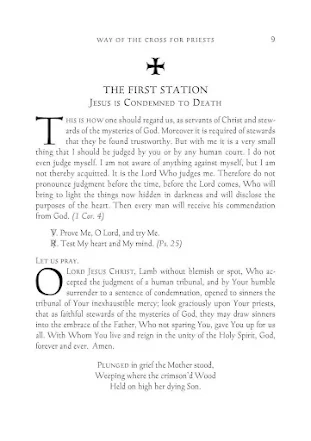The following review was written by a parish priest.
The days of a widespread iconoclastic approach toward popular piety seem to be behind us. (The very phrase popular piety is no longer the slur it once was.) Happily, and despite the controversies of the day, a re-seizing of traditional Catholic liturgical life is taking place. Nevertheless, the right tools are needed in order for this rebirth to continue apace. I have one such tool before me at the moment in The Way of the Cross for Priests, by the monks of Silverstream Priory.
The preface to the volume is powerful in its own right; two themes are notable. First, the author cites the experience of the great Benedictine abbot, Columba Marmion (1858-1923.) “After the Sacraments and liturgical worship,” writes Marmion, “I am convinced there is no practice more fruitful for our souls than the Way of the Cross made with devotion.” For those who know this master of the spiritual life, that is endorsement enough. Second, we are shown how The Way of the Cross resembles the practice of lectio divina. Like this discipline of monastic prayer, The Way of the Cross is a rhythmed, ordered approach to the graces of Christ's Person.
The Way of the Cross for Priests has a number of other virtues. It is faithful to St Benedict’s injunction that prayer should be “short and pure.” Admittedly, some versions of the Stations tend toward the verbose. Yet the Passion is a heavy enough mystery as it is: manageable, but profound texts are what we need most. Silverstream’s Way provides this. Mimicking the genius of the classical Roman Rite, the texts are drawn from beautifully disparate places in the Old and New Testaments: Job, Isaiah, the Psalms, the epistles of St Paul, and the Gospels.
The Cenacle Press at Silverstream produces volumes of physical beauty, which is by no means unimportant. So the little book is a delight to behold and use. Also, the English translation of the Stabat Materis dignified and sung easily.
It is by no means the case that The Way of the Cross for Priests is suitable for the priest’s private prayer only. On the contrary, it will do much to mature and strengthen the Catholic faithful, who in our time have recovered the instinct to pray assiduously for their priests. Thanks be to God for that. Writes Marmion, “The Passion is the ‘holy of holies’ among the mysteries of Jesus, the pre-eminent work of our Supreme High Priest.” Any means which can drive us into this holy of holies is worthy of our serious attention: thus The Way of the Cross for Priests.
The preface to the volume is powerful in its own right; two themes are notable. First, the author cites the experience of the great Benedictine abbot, Columba Marmion (1858-1923.) “After the Sacraments and liturgical worship,” writes Marmion, “I am convinced there is no practice more fruitful for our souls than the Way of the Cross made with devotion.” For those who know this master of the spiritual life, that is endorsement enough. Second, we are shown how The Way of the Cross resembles the practice of lectio divina. Like this discipline of monastic prayer, The Way of the Cross is a rhythmed, ordered approach to the graces of Christ's Person.
The Way of the Cross for Priests has a number of other virtues. It is faithful to St Benedict’s injunction that prayer should be “short and pure.” Admittedly, some versions of the Stations tend toward the verbose. Yet the Passion is a heavy enough mystery as it is: manageable, but profound texts are what we need most. Silverstream’s Way provides this. Mimicking the genius of the classical Roman Rite, the texts are drawn from beautifully disparate places in the Old and New Testaments: Job, Isaiah, the Psalms, the epistles of St Paul, and the Gospels.
The Cenacle Press at Silverstream produces volumes of physical beauty, which is by no means unimportant. So the little book is a delight to behold and use. Also, the English translation of the Stabat Materis dignified and sung easily.
It is by no means the case that The Way of the Cross for Priests is suitable for the priest’s private prayer only. On the contrary, it will do much to mature and strengthen the Catholic faithful, who in our time have recovered the instinct to pray assiduously for their priests. Thanks be to God for that. Writes Marmion, “The Passion is the ‘holy of holies’ among the mysteries of Jesus, the pre-eminent work of our Supreme High Priest.” Any means which can drive us into this holy of holies is worthy of our serious attention: thus The Way of the Cross for Priests.
 |
| (sample page) |

